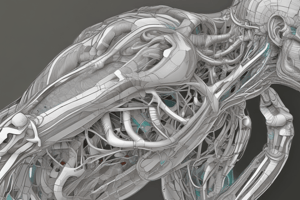Podcast
Questions and Answers
What is the function of the Medial Glenohumeral Ligament in the shoulder joint?
What is the function of the Medial Glenohumeral Ligament in the shoulder joint?
- Prevents joint dislocation and restricts certain ranges of motion (correct)
- Allows complete range of motion without restriction
- Increases shoulder flexibility
- Facilitates internal rotation and adduction
Which ligament prevents joint dislocation and restricts end Range of Motion similarly to the Inferior Glenohumeral Ligament?
Which ligament prevents joint dislocation and restricts end Range of Motion similarly to the Inferior Glenohumeral Ligament?
- Anteroposterior Axis Ligament
- Posterior Band of IGHL (correct)
- Medial Glenohumeral Ligament
- Longitudinal Axis Ligament
What is the primary role of the Rotator Cuff muscles (SITS) in shoulder stability during movement?
What is the primary role of the Rotator Cuff muscles (SITS) in shoulder stability during movement?
- Providing stability during active Range of Motion (correct)
- Inducing joint dislocation
- Allowing unrestricted movement
- Promoting increased flexibility
Which axis of rotation is associated with the restriction of internal rotation in the Glenohumeral Joint?
Which axis of rotation is associated with the restriction of internal rotation in the Glenohumeral Joint?
What end Range of Motion movements are restricted by the Posterior Band of IGHL?
What end Range of Motion movements are restricted by the Posterior Band of IGHL?
Which ligament helps prevent joint dislocation and restricts end Range of Motion for extension?
Which ligament helps prevent joint dislocation and restricts end Range of Motion for extension?
What is primarily responsible for providing stability to the Glenohumeral Joint when it moves through its normal active Range of Motion?
What is primarily responsible for providing stability to the Glenohumeral Joint when it moves through its normal active Range of Motion?
Which ligament restricts end Range of Motion for abduction in the Glenohumeral Joint?
Which ligament restricts end Range of Motion for abduction in the Glenohumeral Joint?
Which axis of rotation is associated with restricting flexion and adduction?
Which axis of rotation is associated with restricting flexion and adduction?
What is the function of the Longitudinal Axis Ligament in controlling movement in the Glenohumeral Joint?
What is the function of the Longitudinal Axis Ligament in controlling movement in the Glenohumeral Joint?
Flashcards are hidden until you start studying
Study Notes
The Shoulder Range of Motion: Glenohumeral Joint
Sagittal Plane: Flexion
- When the shoulder is flexed above horizontal, scapular posterior tilt increases the normal Active Range of Motion to approximately 180 degrees.
Sagittal Plane: Extension
- Without scapular motion, the shoulder has a normal Active Range of Motion of approximately 0 degrees.
- When the shoulder is extended, scapular anterior tilt increases the normal Active Range of Motion to approximately 60 degrees.
Frontal Plane: Abduction
- Without scapular motion, the shoulder has a normal Active Range of Motion of approximately 90 degrees.
- When the shoulder is abducted above 90 degrees, scapular elevation and upward rotation increase the normal Active Range of Motion to approximately 180 degrees.
Frontal Plane: Adduction
- Without scapular motion, the shoulder has a normal Active Range of Motion of approximately 0 degrees.
- When the shoulder is adducted anterior to the body, scapular depression and downward rotation increase the normal Active Range of Motion to approximately 75 degrees.
Transverse Plane: Internal Rotation
- The shoulder has a normal Active Range of Motion of approximately 90 degrees.
- The scapula abducts during internal rotation of the shoulder.
Transverse Plane: External Rotation
- The shoulder has a normal Active Range of Motion of approximately 90 degrees.
- The scapula adducts during external rotation of the shoulder.
Frontal Plane: Horizontal Abduction
- The shoulder has a normal Active Range of Motion of approximately 45 degrees.
- The scapula adducts during horizontal abduction of the shoulder.
Frontal Plane: Horizontal Adduction
- The shoulder has a normal Active Range of Motion of approximately 130 degrees.
- The scapula abducts during horizontal adduction of the shoulder.
The Shoulder Neuromuscular
Glenohumeral Joint
- The muscles of the shoulder joint are innervated by the brachial plexus.
- The brachial plexus includes nerve branches C5-T1.
Muscle Actions
- Deltoid
- Pectoralis Major
- Latissimus Dorsi
- Teres Major
- Coracobrachialis
- Biarticular Muscles:
- Biceps Brachii
- Triceps Brachii
- Rotator Cuff:
- Subscapularis
- Supraspinatus
- Infraspinatus
- Teres Minor
Studying That Suits You
Use AI to generate personalized quizzes and flashcards to suit your learning preferences.




